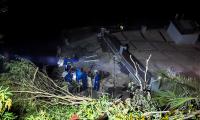bombing.
Since the early 1990s, military engagement in controlling law and order and conducting relief activities worldwide has grown significantly because Armies have proved they can provide unmatched search and rescue capacity, timely logistical support, desired expertise and material resources needed for infrastructure projects, trained manpower and even security for relief workers.
Many global defence experts have viewed that most international armies are trained in prevention, mitigation, preparedness, response (rescue and relief), rehabilitation and reconstruction, though they are traditionally called in to assist in the response stage of the disaster management cycle for search, rescue and relief.
We all know how the Pakistani armed forces have been playing their operational and coordination role in the humanitarian response during numerous devastating floods, deadly earthquakes and land-sliding incidents, which continue to rock the country since its inception.
After the October 8, 2005 earthquake the Pakistani Armed Forces, under a constitutional mandate, were among the first to respond to the crisis. Troops were mobilised within 72 hours to evacuate people and distribute immediate life-saving assistance, including rations from the military’s own supplies.
Over 600 boats and a range of aircraft, including C-130 planes and helicopters, were used to reach cut-off parts of the country, helping at least 850,000 people to escape to safety.
The Pakistani military had also set up field hospitals, mobile veterinary teams, and over 100 relief camps, even before the international community had flown in to mount the largest humanitarian helicopter airlift ever seen.
Moreover, the Pakistani Armed forces have quite often been called in by many civilian regimes to restore law and order in restive parts of the country, to curb internal terrorism, to crush armed rebellions, and to ensure security during the country’s elections etc.
However, a research project carried out by the Stockholm International Peace Research Institute (SIPRI) and the United Nations Office for the Coordination of Humanitarian Affairs has raised a few questions on role of foreign militaries in disasters.
The project report had stated: “Foreign military assets have made large contributions to several recent natural disaster relief operations, yet their use in such operations remains controversial. The questions asked range from matters of principle-is it appropriate for foreign forces to take part in humanitarian work?-to more practical considerations such as cost, how effectively foreign military assets can participate in civilian-led humanitarian operations and how the presence of foreign military assets affects the ability of civilian humanitarian organisations to act independently and safely.”
This study had provided an overview of the current use of foreign military assets in natural disaster response, including how and why they are deployed.
It had also analysed the role played by foreign military assets in several major disasters such as the Mozambique floods of 2000, the Haiti floods of 2004, the Indian Ocean tsunami of 2004 and the October 2005 earthquake in Azad Kashmir.
In the United States, the military has often been summoned to support natural disaster relief operations and civil emergencies, although state governments are responsible for managing these catastrophes.
When Hurricane Katrina had struck the United States on August 29, 2005, the American military was already mobilised for emergency response. It was the costliest natural disaster hitting America (total property damage was estimated at US$108 billion in 2005), besides being one of the five deadliest hurricanes in the US history.
At least 1,245 people had perished in severe destruction caused by the storm and subsequent flooding.
Almost 10,000 US National Guard troops were on the ground in Louisiana and Mississippi to start rescue and relief operations. Within 12 hours, 9,000 people had been evacuated through the airport.
In 1989, the US Army had played a major role in disaster response when Hurricane Hugo had caused a $10 billion loss in direct damage to South Carolina, North Carolina, Puerto Rico and the Virgin Islands.
It was also extremely active during the 1989 California earthquake, which had claimed 63 lives due to collapse of numerous man-made structures.
About 12 US federal agencies (10 civilian and two military) have normally led the responsibility for assisting states in specific emergency situations. All military response is assigned to the Department of Defence and their involvement is coordinated by a Federal Coordinating Officer.
Research shows that the 1878 “Posse Comitatus Act” had limited the powers of the federal government in using the military personnel to enforce domestic policies within the United States.
However, the 1981 Military Cooperation with Civilian Law Enforcement Agencies Act had allowed the US military to cooperate with its civilian law enforcement agencies in counter-drug operations, assistance for civil disturbances, special security operations, combating terrorism and explosive ordnance disposal etc.
In September 26, 2006, the then US President George Bush had urged Congress to consider revising federal laws so that the American armed forces could restore public order and enforce laws in the aftermath of a natural disaster, terrorist attack or any untoward incident.
Signed into law on October 17, 2006, it had empowered the president to employ the armed forces to restore public order and enforce the laws of the United States in case of natural disasters, epidemics, serious public health emergencies, domestic violence, any insurrection or terrorist attacks etc.
It is imperative to note that on March 10, 2009, US Army had reacted on its own in Alabama State in response to a murder spree. The soldiers had assisted in traffic control and securing the crime scene.
In India, where earthquakes, floods, landslides and cyclones are quite common, the country’s armed forces had executed the relief, rescue and evacuation assignments under “Operation Sea Wave” in the aftermath of the 2004 Indian Ocean tsunami.
The Indian forces had also extended aid to Sri Lanka and Maldives under “Operation Rainbow” and “Operation Castor” respectively at the request of their respective governments for assistance.
Claiming to be adequately equipped with the necessary technical competence, manpower and material resources to undertake rescue and relief operations following natural calamities or man-made disasters, the Indian armed forces have worked during the cyclones in Bangladesh, the December 2004 tsunami, the 2005 Kashmir earthquake, the Maharshtra floods of 2005, the January 2008 fire breakout at a Kolkata market, the Bangalore and Ahmadabad bomb blasts in July 2008, the 2008 Kosi floods, the 2010 Leh cloud burst, the Sikkim earthquake in 2011, the 2013 Uttarakhand disaster and the 2013 Cyclone Phailin etc, after the civil administration was found ill equipped for undertaking disaster response activities.
In its August 15, 2014 edition, the “Times of India” had stated: “India’s vulnerability to natural disasters can be traced to several geophysical and climactic factors that lead to frequent earthquakes, floods, cyclones and landslides. Recall the earthquakes at Latur, Bhuj or Kashmir, the Leh mudslide and the Uttrakhand floods. The Kosi floods are the latest tragedy to strike us. Then there are the man-caused disasters. These include Industrial and biological disasters besides NBC (Nuclear, Biological, Chemical) hazards. We will have to prepare increasingly and more robustly to cope with nuclear disasters, even as it becomes an important source of energy for us.”
India’s defence forces have also helped foreign nations cope up with similar tragedies. For example, they were seen assisting the local authorities during the Cyclone Nargis relief work in Myanmar, the Chinese earthquake in 2008, the medical emergency in Sri Lanka in 2009 and 2011, the MH 370 (Malaysian Airlines) disaster in Indian Ocean and the November 2013 Typhoon Haiyan in Phillipines etc.
The secondary role of the Indian armed forces in aid to civil authority is a constitutional obligation, although as an instrument of last resort.
In June 1984, Indian Army had helped Indira Gandhi quell a Sikh rebellion by launching “Operation Blue Star” in order to establish control over Amritsar’s Golden Temple.
The armed forces can be called out to aid the civil authorities to meet various contingencies such as maintaining law and order, to maintain essential services, to assist in natural calamities and to help in execution of developmental projects etc.
In 2010, India had formed two new army divisions - comprising more than 36,000 men - to defend the northeastern state of Arunachal Pradesh.
A BBC report of November 2010 had stated: “The remote northeastern state adjoins China which claims large parts of it. The 56th Division will be based in the nearby state of Nagaland to guard the eastern flank of Arunachal Pradesh from Chinese attack through Burma. In addition there are counter-insurgency troops in Assam that can be sent to the Sino-Indian border at short notice. A total of 1,260 officers and 35,011 soldiers have been assigned to the two new divisions, which are being especially equipped for mountain warfare. India is also raising a paramilitary force called the Arunachal Scouts and Sikkim Scouts to help the army protect the Sino-Indian border in the states of Arunachal Pradesh and Sikkim.”
Indian army soldiers have also supervised and led security duties during the electoral exercises in places like Held Kashmir, where they have frequently been accused of committing genoicide, rapes, killings, abductions and other brutalities.
Indian paramilitary forces were also deployed in the embattled state of Chhattisgarh during last year’s general elections.
The British military had assisted the civil administration during the 2007 floods, which had brought devastation to thousands of homes. Soldiers, sailors and airmen had successfully launched the search and rescue operations to airlift dozens of stranded civilians to safety as raging floodwaters had entered homes and businesses. The Royal Air Force had protected electrical installations and had saved thousands of lives in series of destructive floods during the summer of 2007.
The UK Environment Agency had reported in 2010 that the scale and seriousness of the summer 2007 floods were sufficient to classify them as a national disaster, estimating the damage at about £3.2 billion in 2007 prices.
There are many other examples of the British Armed Forces providing military aid.
For example, it was on duty during the Foot and Mouth outbreak in 2001, the National firefighters’ strikes in 2002 and 2003, the Buncefield fire in 2005, the 2012 Olympic Games, the East Coast Tidal Surge 2013 and the flooding in the South of England in 2014.
In United Kingdom, military aid can be sought to support the civil authorities when they have an urgent need for help to deal with an emergency arising from a natural disaster or a major incident. Aid is provided on an ‘as available’ basis and cannot be assumed.
All military operations within the UK fall under the generic title of UK Operations (UK Ops), which comprises the Armed Forces’ response to a wide range of contingencies and emergencies during peace, periods of tension and crisis and war.
In Japan, armed forces respond to calls for assistance from civilian governors to aid in firefighting, earthquake disasters, searches for missing persons, rescues, reinforcement of embankments and levees in the event of flooding.
This role of the Japanese armed forces is governed by Article 83 of the Self-Defence Forces Law of 1954.
Between 1984 and 1988, at the request of prefectural governors, the Japanese Self-Defense Forces (SDF) had assisted in approximately 3,100 disaster relief operations, involving about 138,000 personnel, 16,000 vehicles, 5,300 aircraft, and 120 ships and small craft.
In recent past, the Japanese forces have also participated in public works projects and have cooperated in managing major sports events. They have built new roads, irrigation networks and schools in areas close to defence bases and have installed soundproofing in homes and public buildings near airfields.
Following the earthquake-triggered March 2011 Fukushima Daiichi nuclear power plant accident, Defense Minister Kitazawa had ordered the dispatch of 50,000 members of the Japanese Self-Defense Forces to aid in the relief work.
For the interest of our readers, it is due to this particular accident that Tokyo still experiences spells of load shedding on recurring basis.
In China, troops were deployed in the aftermath of the May 12, 2008 earthquake in Sichuan province.
The natural calamity had killed 69,197 people and had left 18,222 missing. The earthquake had left about 4.8 million people homeless too, though the number could be as high as 11 million.
The extent of financial damage due to this tragedy can be gauged from the fact that in November 2008, the Chinese government had announced it would spend about US$146.5 billion over the next three years to rebuild areas ravaged by the quake.
The military response to the earthquake was rapid, as the first Chinese military rescue team had reportedly headed for the disaster area within 14 minutes after the strong earthquake began!
Within a week, China’s armed forces claimed they had reportedly dispatched more than 100,000 soldiers and armed police to help with rescue operations in earthquake-hit areas, dividing their units into three geographical rescue zones.
The Chinese military transport aircraft and helicopters had made 1,069 flights during the first week of operations, supplemented by 92 military trains and about 110,000 military vehicles, cranes, rubber boats, portable communication devices, and power generators.
In Indonesia, after the December 26, 2004 tsunami had caused horrendous damages in the Aceh province, the country’s Army had searched for survivors; it buried dead bodies, and had provided water, food, and shelter for those affected. The disaster had resulted in death of 130,000 local Acehnese people and displacement of 400,000 others.
Prior to the 2004 tsunami, over 15,000 people in Aceh had died during a 30-year conflict with the Army. What had begun as a struggle for independence in 1976 evolved into a fight for the control over natural resources revenues, though the Indian Ocean tsunami had pushed both conflicting sides to dispute resolution. A peace deal was hence signed in Helsinki between the Indonesian government and the rebels on August 15, 2005.
The rebels had consequently handed over a quarter of their weapons by September 2005 and the Indonesian military had opted to withdraw 25 percent of troops.
Military resources were also used by Bangladesh after the deadly April 29, 1991 cyclone had killed at least 138,000 people leaving as many as 10 million homeless, besides causing an estimated $1.5 billion (1991 US dollars) in damage to private and state properties.
The command structure, trained manpower and capabilities of the Bangladeshi Armed Forces had led the disaster management initiative.
It goes without saying that while the US Marines had also launched “Operations Sea Angels” to assist the Bangladeshi forces in post disaster rescue and relief operations, Japan and Pakistan had also greatly helped controlling the situations.
Spontaneous assistance in terms of relief materials had also followed from India, Kuwait, Oman and Saudi Arabia.
Members of both groups used automatic weapons against each other
Killed terrorists remained actively involved in targeting LEAs as well as innocent civilians
PPP chief offered condolences to Larkana Hindu Panchayat Chairman, Vice Chairman and Mukhi over Sanjay Kumar’s murder
Maryam Nawaz directed to ensure proper seating arrangements and fans in waiting areas
Emir of Qatar warmly reciprocated prime minister’s Eid greetings and conveyed his best wishes for people of Pakistan
KP govt ordered high-level inquiry into incident and announced compensation of Rs5m for each victim of drone attack







